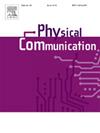Adaptive access strategy for satellite-terrestrial optical networks based on particle swarm optimization algorithm
IF 2
4区 计算机科学
Q3 ENGINEERING, ELECTRICAL & ELECTRONIC
引用次数: 0
Abstract
Satellite-to-terrestrial laser communications offer high bandwidth and security, making the integration of satellites and terrestrial infrastructure into a high-speed communications network critical. In satellite-terrestrial optical networks (STON), frequent link handovers necessitate an efficient access process to establish high-capacity and reliable laser links. We propose a novel and efficient optical network satellite adaptive access (ONSAA) strategy to reduce satellite access frequency while enhancing network capacity. For the first time, this strategy integrates the unique Pointing, Acquisition, and Tracking (PAT) process of satellite laser communication. The satellite access process is divided into two parts: satellite selection and the PAT process. Optimizing these two components independently can improve overall network performance. To optimize satellite selection, We apply a particle swarm optimization (PSO) algorithm, which effectively balances the capacity and dynamics of STON. Additionally, we propose a multi-scans method for the PAT process to increase satellite access success rates, thereby reducing the frequency of access requests. This method also minimizes docking delay, which in turn extends the link transmission time for successful connections between the optical ground station (OGS) and the satellite network. Docking delay refers to the time required to successfully access the satellite. Simulation results demonstrate that this strategy reduces the number of accesses and enhancing network capacity, while the optimized PAT process ensure fast and reliable connections presenting a promising solution for future STON applications.
求助全文
约1分钟内获得全文
求助全文
来源期刊

Physical Communication
ENGINEERING, ELECTRICAL & ELECTRONICTELECO-TELECOMMUNICATIONS
CiteScore
5.00
自引率
9.10%
发文量
212
审稿时长
55 days
期刊介绍:
PHYCOM: Physical Communication is an international and archival journal providing complete coverage of all topics of interest to those involved in all aspects of physical layer communications. Theoretical research contributions presenting new techniques, concepts or analyses, applied contributions reporting on experiences and experiments, and tutorials are published.
Topics of interest include but are not limited to:
Physical layer issues of Wireless Local Area Networks, WiMAX, Wireless Mesh Networks, Sensor and Ad Hoc Networks, PCS Systems; Radio access protocols and algorithms for the physical layer; Spread Spectrum Communications; Channel Modeling; Detection and Estimation; Modulation and Coding; Multiplexing and Carrier Techniques; Broadband Wireless Communications; Wireless Personal Communications; Multi-user Detection; Signal Separation and Interference rejection: Multimedia Communications over Wireless; DSP Applications to Wireless Systems; Experimental and Prototype Results; Multiple Access Techniques; Space-time Processing; Synchronization Techniques; Error Control Techniques; Cryptography; Software Radios; Tracking; Resource Allocation and Inference Management; Multi-rate and Multi-carrier Communications; Cross layer Design and Optimization; Propagation and Channel Characterization; OFDM Systems; MIMO Systems; Ultra-Wideband Communications; Cognitive Radio System Architectures; Platforms and Hardware Implementations for the Support of Cognitive, Radio Systems; Cognitive Radio Resource Management and Dynamic Spectrum Sharing.
 求助内容:
求助内容: 应助结果提醒方式:
应助结果提醒方式:


